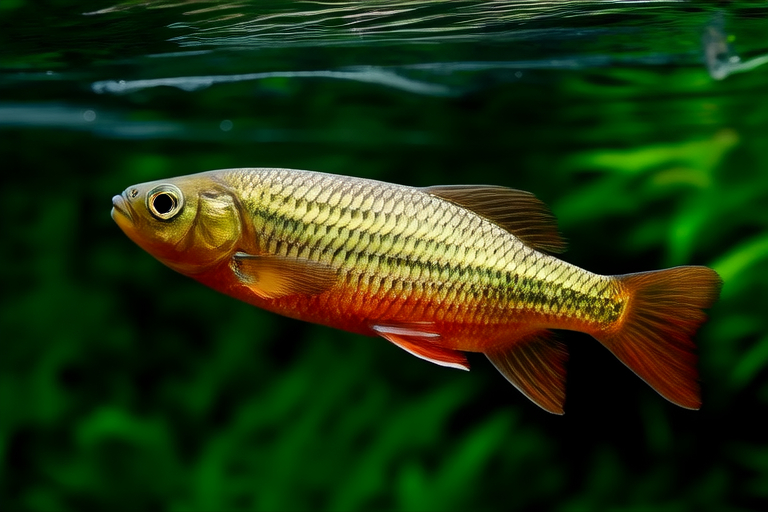From Asia to Your Tank: The Majestic Journey of the Arowana
The arowana, often referred to as the dragonfish due to its striking appearance and mythical connotations, is one of the most sought-after freshwater fish species among aquarium enthusiasts. Originating from the rivers and swamps of Southeast Asia, these magnificent creatures have captivated the hearts of aquarists worldwide with their unique physical attributes and rich cultural heritage.
Origins and Physical Characteristics
Arowanas are native to the tropical waters of countries such as Indonesia, Malaysia, Thailand, and parts of South America. They thrive in warm, slow-moving rivers and murky waters, where they can reach lengths of up to three feet. These fish are characterized by their elongated bodies, large scales, and powerful dorsal fins. Their eyes are positioned high on their heads, allowing them to see above the water’s surface, a trait that has earned them the nickname ‘monitors of the river.’
Their scales are particularly noteworthy; they are large, thick, and metallic, ranging in color from silver to green, depending on the species. Some varieties even exhibit iridescent hues that shimmer under light, adding to their allure. The most famous species include the Asian arowana (Scleropages formosus), known for its vibrant red scales, and the African arowana (Heterotis niloticus), which is less common in the aquarium trade but equally impressive.
Cultural Significance
In many Asian cultures, the arowana is considered a symbol of good luck and prosperity. In Chinese tradition, it is believed that keeping an arowana brings wealth and protection to the home. This belief is rooted in the fish’s resemblance to the mythical Chinese dragon, a creature associated with power and fortune. As a result, owning an arowana is seen as a status symbol among collectors and enthusiasts.
The arowana’s cultural importance extends beyond mere superstition. It plays a significant role in traditional ceremonies and rituals, especially in areas where it is indigenous. For instance, in some regions of Indonesia, the arowana is revered as a sacred animal, and its capture or trade is strictly regulated to preserve the species.
The Trade and Conservation Challenges
The journey of the arowana from its natural habitat to your aquarium is fraught with challenges. Overfishing and habitat destruction have significantly reduced wild populations, leading to strict regulations on the trade of these fish. Many countries, including Singapore, Malaysia, and Indonesia, have implemented laws to protect the arowana and ensure sustainable practices in the aquarium trade.
The Convention on International Trade in Endangered Species of Wild Fauna and Flora (CITES) lists the Asian arowana as Appendix I, meaning international trade is prohibited except for scientific purposes. This classification underscores the urgency of conservation efforts and the need for responsible breeding programs to meet the demand without further endangering the species.
Despite these regulations, illegal trade persists, driven by the high market value of the arowana. The challenge lies in balancing the desire for exotic pets with the need to conserve these magnificent creatures. Responsible aquarists must be aware of the legal and ethical implications of purchasing an arowana and support sustainable breeding initiatives.
Tips for Keeping Arowana
For those fortunate enough to own an arowana, proper care is essential to ensure their well-being. Here are some tips for setting up a suitable environment:
- Tank Setup: Arowanas require spacious tanks, ideally no smaller than 180 gallons for a single adult. The tank should be long rather than tall to allow ample swimming space. Use a robust filtration system capable of handling the large volume of water and the fish’s waste production.
- Diet: Arowanas are carnivorous and require a diet rich in protein. Feed them a variety of live or frozen foods, such as feeder fish, shrimp, and worms. Ensure that the food is appropriately sized to prevent choking hazards.
- Water Quality: Maintain optimal water conditions by regularly testing pH levels, ammonia, nitrite, and nitrate concentrations. Aim for a pH between 6.5 and 7.5 and keep temperature around 78-84°F.
- Behavioral Considerations: Arowanas are territorial and may display aggressive behavior towards other fish, especially those of similar size. Provide hiding spots and ample space to minimize stress and potential conflicts.
Reflection on Responsibility
The journey of the arowana from the rivers of Asia to your tank is a testament to the enduring fascination humans have with nature’s wonders. However, it also highlights the delicate balance between fulfilling our desires and preserving biodiversity.
As aquarists, we have a responsibility to approach the ownership of these majestic creatures with respect and care. By supporting sustainable breeding practices and adhering to legal guidelines, we contribute to the conservation of the arowana. Let us embrace our role as stewards of these magnificent fish, ensuring that future generations can marvel at their beauty and grace.
From Asia to your tank, the arowana’s journey is one of wonder, responsibility, and preservation. Let us honor this journey by cherishing and protecting these remarkable creatures.
